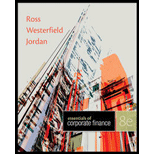
a)
To determine: The relationship that exists between the yield to maturity and the
Introduction:
A bond refers to the debt securities issued by the governments or corporations for raising capital. The borrower does not return the face value until maturity. However, the investor receives the coupons every year until the date of maturity.
If the bond sells at a steep discount during the issue and does not make any coupon payments during its life, then the bond is a zero coupon bond.
Yields refer to the
Bond price refers to the price at which the bond the investors buy and sell in the market. It is the sum of
b)
To determine: The reason why bonds sell at a premium or discount and the relationship between the yield to maturity and the coupon rate of premium, discount, and par bonds.
Introduction:
A bond refers to the debt securities issued by the governments or corporations for raising capital. The borrower does not return the face value until maturity. However, the investor receives the coupons every year until the date of maturity.
If the bond sells at a steep discount during the issue and does not make any coupon payments during its life, then the bond is a zero coupon bond.
Yields refer to the return on the investment made by an investor. A bond yield refers to the return earned by the investor on the bond if he or she holds the bond until the bond matures.
c)
To determine: The relationship between the yield to maturity and the current yield of par, discount, and premium bonds.
Introduction:
The current yield of the bond is the annual coupon of the bond divided by the price of the bond.
Want to see the full answer?
Check out a sample textbook solution
Chapter 6 Solutions
Essentials of Corporate Finance
- A bond with a face value of $1,000 pays a 5% annual coupon and has 10 years to maturity. If the market interest rate is 6%, what is the price of the bond?arrow_forwardWhich of the following represents a source of cash?A) Repayment of a loanB) Purchase of inventoryC) Issuance of new equity sharesD) Purchase of fixed assets Need hwarrow_forwardWhich of the following represents a source of cash?A) Repayment of a loanB) Purchase of inventoryC) Issuance of new equity sharesD) Purchase of fixed assets Exarrow_forward
- The payback period is:A) The time it takes for a project to be profitableB) The time required to recover the initial investmentC) The total time a project lastsD) The period during which a project generates revenuearrow_forwardA bond selling below its par value is referred to as:A) A discount bondB) A premium bondC) A callable bondD) A convertible bondneed help!arrow_forwardA bond selling below its par value is referred to as:A) A discount bondB) A premium bondC) A callable bondD) A convertible bondarrow_forward
- What is the primary purpose of a capital budgeting decision?A) To maximize cash flowsB) To evaluate long-term investment opportunitiesC) To manage short-term liabilitiesD) To determine the company's dividend policyneed helparrow_forwardWhat is the primary purpose of a capital budgeting decision?A) To maximize cash flowsB) To evaluate long-term investment opportunitiesC) To manage short-term liabilitiesD) To determine the company's dividend policyarrow_forwardWhat is diversification in portfolio management?A) Investing in a single industry to maximize returnsB) Spreading investments across different assets to reduce riskC) Concentrating investments in a high-performing stockD) Avoiding low-risk investments entirelyarrow_forward
- What is the primary purpose of a capital budgeting decision?A) To maximize cash flowsB) To evaluate long-term investment opportunitiesC) To manage short-term liabilitiesD) To determine the company's dividend policy explain.arrow_forwardQuestion 10: What is the primary purpose of a capital budgeting decision?A) To maximize cash flowsB) To evaluate long-term investment opportunitiesC) To manage short-term liabilitiesD) To determine the company's dividend policyarrow_forwardNitai (age 40) contributes 10 percent of his $100,000 annual salary to a Roth 401(k) account sponsored by his employer, AY Incorporated. AY Incorporated matches employee contributions dollar-for-dollar up to 10 percent of the employee's salary. However, AY matches by contributing to the employee's traditional 401(k) account because the employer contributions are not fully vested to the employee at the time of the contribution. Nitai expects to earn a 7 percent before-tax rate of return. Assume he leaves the contributions in the Roth 401(k) and traditional 401(k) accounts until he retires in 25 years and that he makes no additional contributions to either account. What are Nitai's after-tax proceeds from the Roth 401(k) and traditional 401(k) accounts after he receives the distributions, assuming his marginal tax rate at retirement is 30 percent? (Use Table 1, Table 2.) after tax proceeds from distribution roth ira: traditional ira:arrow_forward
 Intermediate Financial Management (MindTap Course...FinanceISBN:9781337395083Author:Eugene F. Brigham, Phillip R. DavesPublisher:Cengage Learning
Intermediate Financial Management (MindTap Course...FinanceISBN:9781337395083Author:Eugene F. Brigham, Phillip R. DavesPublisher:Cengage Learning EBK CONTEMPORARY FINANCIAL MANAGEMENTFinanceISBN:9781337514835Author:MOYERPublisher:CENGAGE LEARNING - CONSIGNMENT
EBK CONTEMPORARY FINANCIAL MANAGEMENTFinanceISBN:9781337514835Author:MOYERPublisher:CENGAGE LEARNING - CONSIGNMENT Pfin (with Mindtap, 1 Term Printed Access Card) (...FinanceISBN:9780357033609Author:Randall Billingsley, Lawrence J. Gitman, Michael D. JoehnkPublisher:Cengage Learning
Pfin (with Mindtap, 1 Term Printed Access Card) (...FinanceISBN:9780357033609Author:Randall Billingsley, Lawrence J. Gitman, Michael D. JoehnkPublisher:Cengage Learning



